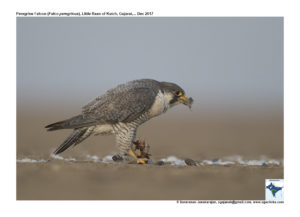Peregrine-falcon

Peregrine Falcon Falco peregrinus
Etymology:
- Falco : Latin for Falcon based on Sickle shaped claws ( falcis- sickle)
- Peregrinus : Latin word peregrinus- wanderer
Vernacular Names: Hindi: (F) Bhyri, Shaaheen kohi, (M) Bhyri bacha, Kohila, Shaheen, Safed shaheen, Pun: Lalsir shaheen, Bahiri, Shahin, Guj: Shaaheen, Kalo shaaheen, Lal mathani shahin, (F) Bheri, Shahin, (M) Bheribacho, Shahincha , Mar: Shaahin sassana/ Bahiri Sasana, Ori: Chhanchana, Ta: Valluru, Te: Bhyri dega, Yerkali: Dega, Mal: Kayal pullu, Karimpullu, Sinh: Kurulla goya
Distribution in India: Wide spread Resident and Winter Visitor.
Fastest Living species on Earth with recorded speeds of 389 Km /Hr in dives.
Description: Size of 38-51 cm. It is a large, stocky falcon, with relatively short tail; prominent mustache usually evident in all ages. Rather variable, with upperparts various tones of blue, grey or black; underparts white to rufous, crossed with variable bars. Noticeable size dimorphism, with female 12–20% larger and 40–70% heavier than male. Juvenile has upperparts with tones of black to pale brown, underparts streaked. Cere and orbital rings yellow to yellow-orange in adult, bluish-white to greenish in juvenile; feet yellow in adult, bluish-grey to bluish-green in juvenile .
Habitat: It is found in hot tropics to cold, wet marine habitat; also arid hot or cold deserts; breeds from sea-level to 3300 m.
Food Habits: It eats chiefly birds; occasionally mammals, including bats, rats, rabbits and voles; also insects, reptiles and exceptionally fish. Birds taken mainly in flight: when searching for prey, often flies high or perches at prominent site; once it locates prey, it typically pursues it at great speed, frequently culminating in very rapid stoop. Prey is typically struck and captured in mid-air; it strikes its prey with a clenched foot, stunning or killing it with the impact, then turns to catch it in mid-air. If its prey is too heavy to carry, it will drop it to the ground and eat it there. If they miss the initial strike, peregrines will chase their prey in a twisting flight. Sometimes prey is taken on ground or water. Many other techniques recorded, including hawking for insects, hovering and quartering. Hunts most often at dawn and dusk, when prey are most active, but also nocturnally in cities, particularly during migration periods when hunting at night may become prevalent.
Breeding Habits: They breed in Feb- March in Northern Hemisphere and July to August in the Southern Hemisphere. The courtship flight includes a mix of aerial acrobatics, precise spirals, and steep dives. The male passes prey it has caught to the female in mid-air. To make this possible, the female actually flies upside-down to receive the food from the male’s talons. No nest is built. The eggs are laid in scrape or depression on cliff, in disused stick nest of another species or in a tree hollow or on ground or below the ground in a sink hole. It lays a clutch of 3-4 eggs. The incubation period is 29–32 days. The replacement of lost clutch may occur within 2 weeks. The chicks are born altricial, adult male provides most of food during first half of nestling period. The fledging period is 35–42 days. The chicks remain dependent on parents for 2 months.